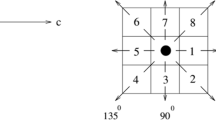Abstract
With the advent of the era of information explosion, multimedia big data with images as the main carrier has increased dramatically and has penetrated into various fields of people’s lives. As the basis of image recognition, classification has become an important tool for analyzing and understanding image information. Therefore, how to quickly and efficiently image classification has become a challenging research hotspot. In order to solve the limitation of traditional machine learning algorithm in classification performance, an image classification method based on chaotic optimization machine learning algorithm is proposed. This method combines the support vector machine in the machine learning algorithm with the chaotic time series to construct the classification prediction model. The particle swarm optimization algorithm is used to realize the optimal parameter search of the support vector machine to improve the performance of the prediction model. The test results show that compared with other multi-machine learning algorithm predictions, the proposed method effectively reduces the dependence of classification results on sample types and features, and has a higher and robust classification effect.



Similar content being viewed by others
References
Aiguo L, Yuntao X, Jianglu H et al (2015) Ultra-short-term prediction of wind power based on GA-optimized SVM[J]. Pow Sys Protect & Control 43(2):90–95
Barata C, Celebi ME, Marques JS (2015) Improving dermoscopy image classification using color constancy[J]. IEEE Journal of Biomedical & Health Informatics 19(3):1146
Cabral R, Torre FDL, Costeira JP et al (2015) Matrix completion for weakly-supervised multi-label image classification[J]. IEEE Trans Pattern Anal Mach Intell 37(1):121–135
Cao J, Chen L, Wang M et al (2016) A parallel Adaboost-backpropagation neural network for massive image dataset classification[J]. Sci Rep 6(1):382–387
Faggini M (2014) Chaotic time series analysis in economics: balance and perspectives[J]. Chaos 24(4):6593–6598
Gong C, Tao D, Maybank SJ et al (2016) Multi-modal curriculum learning for semi-supervised image classification[J]. IEEE Trans Image Process 25(7):3249–3260
Khatami R, Mountrakis G, Stehman SV (2016) A meta-analysis of remote sensing research on supervised pixel-based land-cover image classification processes: general guidelines for practitioners and future research[J]. Remote Sens Environ 177:89–100
Koreen M, Murray R (2015) On the importance of training data sample selection in random forest image classification: a case study in peatland ecosystem mapping[J]. Remote Sens 7(7):8489–8515
Lin YJ, Chen XJ (2014) BP neural network learning algorithm and its software implementation[J]. Appl Mech Mater 513-517(513–517):738–741
Luo Y, Liu T, Tao D et al (2015) Multiview matrix completion for multilabel image classification[J]. IEEE Trans Image Process 24(8):2355–2368
Maggiori E, Tarabalka Y, Charpiat G et al (2016) Convolutional neural networks for large-scale remote sensing image classification[J]. IEEE Trans Geosci Remote Sens 55(2):645–657
Masdari M, Salehi F, Jalali M et al (2017) A survey of PSO-based scheduling algorithms in cloud computing[J]. J Netw Syst Manag 25(1):122–158
Pasolli E, Melgani F, Tuia D et al (2014) SVM active learning approach for image classification using spatial information[J]. IEEE Trans Geosci Remote Sens 52(4):2217–2233
Li Y, Li Y (2017) A face recognition algorithm based on sparse representation and neural network [J]. Rec Pat on Comput Sci 10(4):290–298
Ristin M, Guillaumin M, Gall J et al (2015) Incremental learning of random forests for large-scale image classification. IEEE Trans Pattern Anal Mach Intell 38:490–503
Romero A, Gatta C, Camps-Valls G (2015) Unsupervised deep feature extraction for remote sensing image classification[J]. IEEE Transactions on Geoscience & Remote Sensing 54(3):1349–1362
Tan S, Xu M, Wu L et al (2014) Estimation on hole seeding quantity of super hybrid rice based on machine vision and BP neural network[J]. Trans of Chin Soci of Agricul Engin 30(21):201–208
Wei Y, Xia W, Lin M et al (2016) HCP: a flexible CNN framework for multi-label image classification. IEEE Trans Pattern Anal Mach Intell 38(9):1901–1907
Wenjing Z, Jing B (2016) Optimization and application of a chaotic artificial fish swarm algorithm for SVM parameters[J]. Microelectro & Comput 33(3):89–93
Xiaozhou Y (2018) An improved SVM classification algorithm combining K-nearest neighbor method[J]. J of Imag and Graph14(11):2299–2303
Zuo Z, Wang G, Shuai B et al (2015) Exemplar based deep discriminative and shareable feature learning for scene image classification[J]. Pattern Recogn 48(10):3004–3015
Author information
Authors and Affiliations
Corresponding author
Additional information
Publisher’s note
Springer Nature remains neutral with regard to jurisdictional claims in published maps and institutional affiliations.
Rights and permissions
About this article
Cite this article
Zhang, Y., Zhang, R. Research on multimedia image classification technology based on chaos optimization machine learning algorithm. Multimed Tools Appl 80, 22645–22656 (2021). https://doi.org/10.1007/s11042-019-7636-y
Received:
Revised:
Accepted:
Published:
Issue Date:
DOI: https://doi.org/10.1007/s11042-019-7636-y




